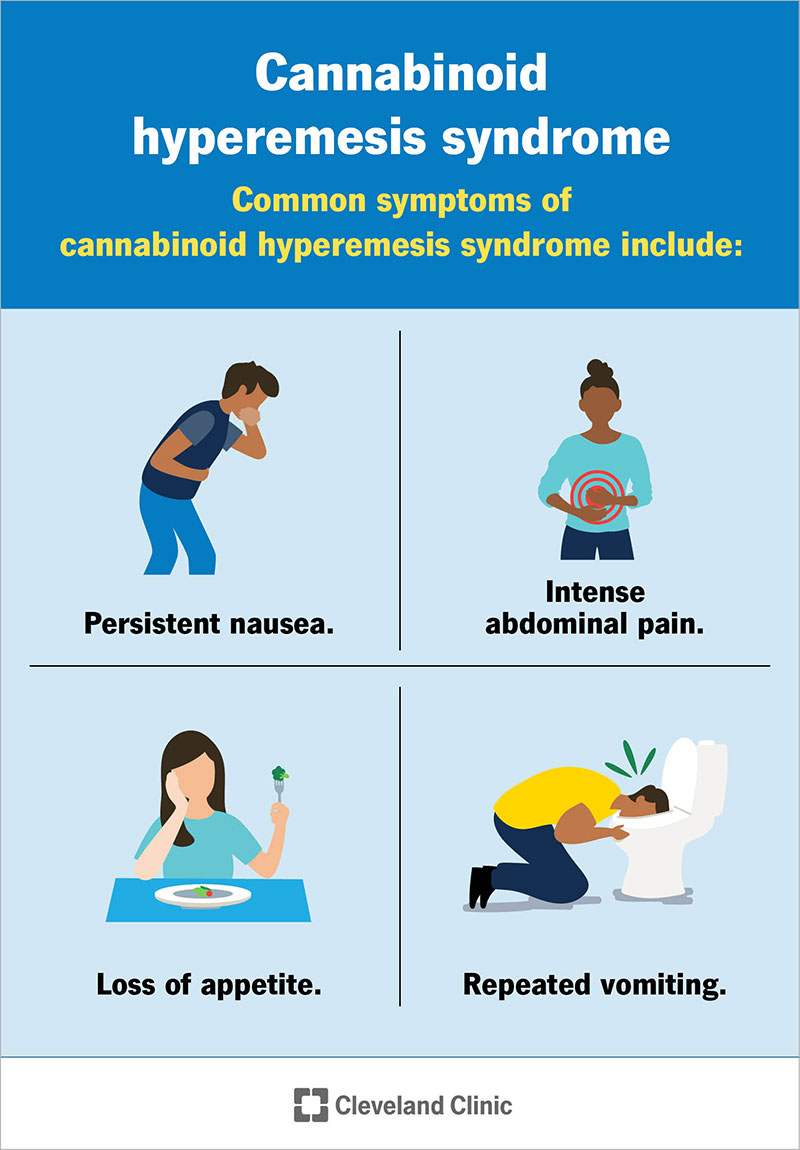Beware Cannabis Hyperemesis Syndrome
"Telltale symptoms of CHS are severe and persistent vomiting.] Scromiting [is a term that's been used, a merger of[ vomiting [and] screaming.""You may have intense pain, which causes you to scream while you vomit.""Cannabinoid hyperemesis syndrome [CHS] can affect people who use cannabis [marijuana)]long-term. CHS causes frequent, severe nausea and vomiting.""Hot baths and showers may temporarily relieve symptoms. But the only way to cure CHS is to stop using cannabis."The Cleveland Clinic
 |
| Symptoms of CHS typically come on several years after the start of chronic marijuana use. ClevelandClinic.org |
"When I talk to youth, they can easily access strains [of pot] that are upwards of 25 percent. And that's huge.""[Youth can mistakenly think using more pot will help with the nausea and pain], but it's actually exacerbating it, because they don't even realize that they have anything called cannabis hyperemesis syndrome.""They're not able to take down food without purging. Chronic use substantially increases the risk of nausea.""[Left untreated severe vomiting and dehydration can lead to acute kidney injury. In rare cases] it can lead to death, if you are that severely dehydrated and you're not getting your electrolytes up.""The most recent data we have from Canada -- and this is kind of alarming -- is that about one in five, or 20 percent of 16- to 19-year-olds have used cannabis in the past month and close to nine percent daily, or almost every single day.""Potency is a huge factor. But there is also now growing social acceptance [of cannabis] and a lot of youth think there is very little harm associated with its use."Jamie Seabrook, professor, epidemiology and biostatistics and department of pediatrics, Western University
 |
| Emergency departments are seeing a surge in cases of cannabis hyperemesis syndrome. THE CANADIAN PRESS/Doug Ives |
Hospital Emergency doctors are reporting increasing cases of cannabis hyperemesis syndrome, a gastrointestinal condition that can affect those who use cannabis frequently over a period of months or years [several times weekly at least, daily at most]. Symptoms of CHS as well as 'cyclical' vomiting may include morning nausea, intense abdominal pain, and finding "relief through compulsive hot showers or baths". According to Western University researchers, the chronic illness increasingly is affecting teens and young adults. "Yet few people -- including many clinicians -- know it exists".
Visits resulting from CHS episodes to emergency departments increased 13-fold in Ontario following the legalization of recreational cannabis in 2018, according to one study. The legalization had no association to a sudden or gradual change in cases; instead the commercialization of pot led to unlimited numbers of stores, more products included, overlapping with the COVID-19 pandemic which led to an immediate rise in cannabis user-rates
And it is the potency of THC (tetrahydro cannabinol) which has drawn concern, as the main psychoactive compound in cannabis. Rising from some 3 percent in dried cannabis in the 1980s to 14 percent in 2023, with some strains as high as 30 percent. THC, its potency in the hands of high schoolers and university attendees is a situation of grave concern. From its first documentation in 2004 by researchers in South Australia, cases of CHS have since been appearing around the world.
 |
| Nausea and early morning discomfort begin in the early stages of CHS. (Shutterstock) |
12,866 emergency department visits by 8,140 individuals were documented between January 2014 and June of 2021; ranging from pre- and post- legalization. Of that number some 35 percent were identified as being between the ages of 19 to 24. Ten percent of visits saw hospital admissions rising as CHS emergency visits increased from 0.26 per 100,000 population in January 2014 to 3.43 visits per 100,000 population in 2021.
"Chronic use substantially increases the risk of nausea", though it remains unclear what causes CHS. Cannabinoids bind to cannabinoid receptors in the brain and gastrointestinal tract. With constant vomiting, food intake and nutrition is challenged. "They're not able to take down food without purging", explained Professor Seabrook. "Some patients become diagnosed with bulimia nervosa on presentation. ''
Hot baths or showers can grant temporary relief but "when they get out, the symptoms reappear", explained Professor Seabrook. Left untreated, severe vomiting and dehydration can lead to acute kidney injury. At risk are most people who develop CHS as a result of long-term cannabis use on a frequent basis. Canada has one of the highest rates of youth cannabis use in the world. Up to around age 25, the human brain continues to develop.Exposure to THC over this period of development has been linked to problems with attention, memory and learning, along with an increased risk of paranoia, psychosis and schizophrenia.
 |
| This rise in regular, heavy use coincides with a 400 per cent increase in THC potency since the 1980s. THE CANADIAN PRESS/Lars Hagberg |
Labels: Canada, Cannabis Hyperemesis Syndrome, Cannabis Legalization, Chronic gastroenteritis, Cyclical vomiting, Increasing Emergency Room Visits
0 Comments:
Post a Comment
<< Home